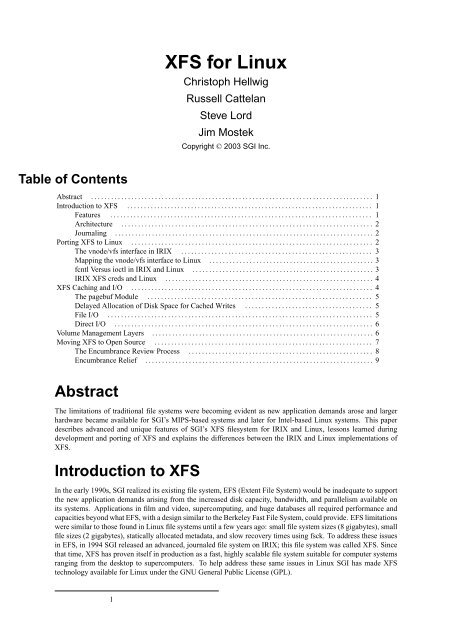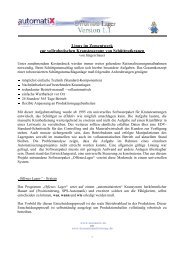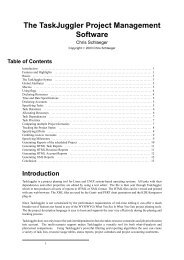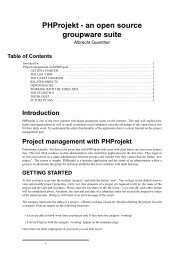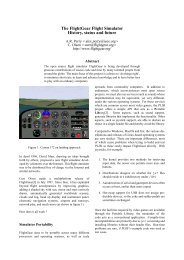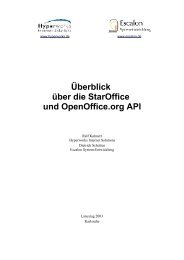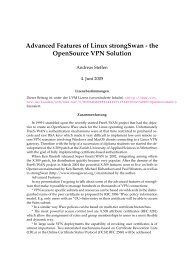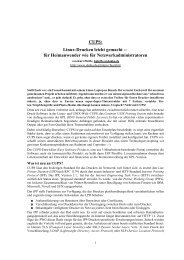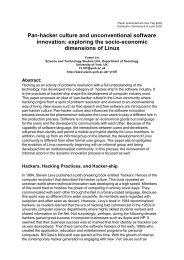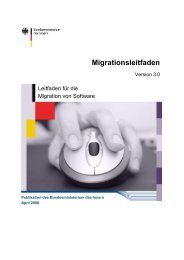You also want an ePaper? Increase the reach of your titles
YUMPU automatically turns print PDFs into web optimized ePapers that Google loves.
Table of Contents<br />
<strong>XFS</strong> <strong>for</strong> <strong>Linux</strong><br />
Christoph Hellwig<br />
Russell Cattelan<br />
Steve Lord<br />
Jim Mostek<br />
Copyright © 2003 SGI Inc.<br />
Abstract . . . . . . . . . . . . . . . . . . . . . . . . . . . . . . . . . . . . . . . . . . . . . . . . . . . . . . . . . . . . . . . . . . . . . . . . . . . . . . . . . . . . 1<br />
Introduction to <strong>XFS</strong> . . . . . . . . . . . . . . . . . . . . . . . . . . . . . . . . . . . . . . . . . . . . . . . . . . . . . . . . . . . . . . . . . . . . . . . . . 1<br />
Features . . . . . . . . . . . . . . . . . . . . . . . . . . . . . . . . . . . . . . . . . . . . . . . . . . . . . . . . . . . . . . . . . . . . . . . . . . . . . . 1<br />
Architecture . . . . . . . . . . . . . . . . . . . . . . . . . . . . . . . . . . . . . . . . . . . . . . . . . . . . . . . . . . . . . . . . . . . . . . . . . . . 2<br />
Journaling . . . . . . . . . . . . . . . . . . . . . . . . . . . . . . . . . . . . . . . . . . . . . . . . . . . . . . . . . . . . . . . . . . . . . . . . . . . . . 2<br />
Porting <strong>XFS</strong> to <strong>Linux</strong> . . . . . . . . . . . . . . . . . . . . . . . . . . . . . . . . . . . . . . . . . . . . . . . . . . . . . . . . . . . . . . . . . . . . . . . . 2<br />
The vnode/vfs interface in IRIX . . . . . . . . . . . . . . . . . . . . . . . . . . . . . . . . . . . . . . . . . . . . . . . . . . . . . . . . . 3<br />
Mapping the vnode/vfs interface to <strong>Linux</strong> . . . . . . . . . . . . . . . . . . . . . . . . . . . . . . . . . . . . . . . . . . . . . . . . . 3<br />
fcntl Versus ioctl in IRIX and <strong>Linux</strong> . . . . . . . . . . . . . . . . . . . . . . . . . . . . . . . . . . . . . . . . . . . . . . . . . . . . . . 3<br />
IRIX <strong>XFS</strong> creds and <strong>Linux</strong> . . . . . . . . . . . . . . . . . . . . . . . . . . . . . . . . . . . . . . . . . . . . . . . . . . . . . . . . . . . . . . 4<br />
<strong>XFS</strong> Caching and I/O . . . . . . . . . . . . . . . . . . . . . . . . . . . . . . . . . . . . . . . . . . . . . . . . . . . . . . . . . . . . . . . . . . . . . . . . 4<br />
The pagebuf Module . . . . . . . . . . . . . . . . . . . . . . . . . . . . . . . . . . . . . . . . . . . . . . . . . . . . . . . . . . . . . . . . . . . 5<br />
Delayed Allocation of Disk Space <strong>for</strong> Cached Writes . . . . . . . . . . . . . . . . . . . . . . . . . . . . . . . . . . . . . . 5<br />
File I/O . . . . . . . . . . . . . . . . . . . . . . . . . . . . . . . . . . . . . . . . . . . . . . . . . . . . . . . . . . . . . . . . . . . . . . . . . . . . . . . 5<br />
Direct I/O . . . . . . . . . . . . . . . . . . . . . . . . . . . . . . . . . . . . . . . . . . . . . . . . . . . . . . . . . . . . . . . . . . . . . . . . . . . . . 6<br />
Volume Management Layers . . . . . . . . . . . . . . . . . . . . . . . . . . . . . . . . . . . . . . . . . . . . . . . . . . . . . . . . . . . . . . . . . . 6<br />
Moving <strong>XFS</strong> to Open Source . . . . . . . . . . . . . . . . . . . . . . . . . . . . . . . . . . . . . . . . . . . . . . . . . . . . . . . . . . . . . . . . . 7<br />
The Encumbrance Review Process . . . . . . . . . . . . . . . . . . . . . . . . . . . . . . . . . . . . . . . . . . . . . . . . . . . . . . . 8<br />
Encumbrance Relief . . . . . . . . . . . . . . . . . . . . . . . . . . . . . . . . . . . . . . . . . . . . . . . . . . . . . . . . . . . . . . . . . . . . 9<br />
Abstract<br />
The limitations of traditional file systems were becoming evident as new application demands arose and larger<br />
hardware became available <strong>for</strong> SGI’s MIPS-based systems and later <strong>for</strong> Intel-based <strong>Linux</strong> systems. This paper<br />
describes advanced and unique features of SGI’s <strong>XFS</strong> filesystem <strong>for</strong> IRIX and <strong>Linux</strong>, lessons learned during<br />
development and porting of <strong>XFS</strong> and explains the differences between the IRIX and <strong>Linux</strong> implementations of<br />
<strong>XFS</strong>.<br />
Introduction to <strong>XFS</strong><br />
In the early 1990s, SGI realized its existing file system, EFS (Extent File System) would be inadequate to support<br />
the new application demands arising from the increased disk capacity, bandwidth, and parallelism available on<br />
its systems. Applications in film and video, supercomputing, and huge databases all required per<strong>for</strong>mance and<br />
capacities beyond what EFS, with a design similar to the Berkeley Fast File System, could provide. EFS limitations<br />
were similar to those found in <strong>Linux</strong> file systems until a few years ago: small file system sizes (8 gigabytes), small<br />
file sizes (2 gigabytes), statically allocated metadata, and slow recovery times using fsck. To address these issues<br />
in EFS, in 1994 SGI released an advanced, journaled file system on IRIX; this file system was called <strong>XFS</strong>. Since<br />
that time, <strong>XFS</strong> has proven itself in production as a fast, highly scalable file system suitable <strong>for</strong> computer systems<br />
ranging from the desktop to supercomputers. To help address these same issues in <strong>Linux</strong> SGI has made <strong>XFS</strong><br />
technology available <strong>for</strong> <strong>Linux</strong> under the GNU General Public License (GPL).<br />
1
Features<br />
<strong>XFS</strong> uses B+ trees extensively in place of traditional linear file system structures. B+ trees provide an efficient<br />
indexing method that is used to rapidly locate free space, to index directory entries, to manage file extents, and to<br />
keep track of the locations of file index in<strong>for</strong>mation within the file system. <strong>XFS</strong> is a fully 64-bit file system. Most<br />
of the global counters in the system are 64-bits in length, as are the addresses used <strong>for</strong> each disk block and the<br />
unique number assigned to each file (the inode number). A single file system can theoretically be as large as 18<br />
million terabytes. The file system is partitioned into regions called Allocation Groups (AG). Like UFS cylinder<br />
groups, each AG manages its own free space and inodes. The primary purpose of Allocation Groups is to provide<br />
scalability and parallelism within the file system. This partitioning also limits the size of the structures needed to<br />
track this in<strong>for</strong>mation and allows the internal pointers to be 32-bits. AGs typically range in size from 0.5 to 4GB.<br />
Files and directories are not limited to allocating space within a single AG.<br />
<strong>XFS</strong> has a variety of sophisticated support utilities to enhance its usability. These include fast mkfs (make a<br />
file system), dump and restore utilities <strong>for</strong> backup, xfsdb (<strong>XFS</strong> debug), xfscheck (<strong>XFS</strong> check), and xfsrepair to<br />
per<strong>for</strong>m file system checking and repairing. The xfs fsr utility defragments existing <strong>XFS</strong> file systems. The xfs<br />
bmap utility can be used to interpret the metadata layouts <strong>for</strong> an <strong>XFS</strong> file system. The growfs utility allows <strong>XFS</strong><br />
file systems to be enlarged on-line.<br />
Architecture<br />
The high level structure of <strong>XFS</strong> is similar to a conventional file system with the addition of a transaction manager.<br />
<strong>XFS</strong> supports all of the standard Unix file interfaces and is entirely POSIX- and XPG4-compliant. It sits below<br />
the vnode interface in the IRIX kernel and takes full advantage of services provided by the kernel, including the<br />
buffer/page cache, the directory name lookup cache, and the dynamic vnode cache.<br />
<strong>XFS</strong> is modularized into several parts, each of which is responsible <strong>for</strong> a separate piece of the file system’s<br />
functionality. The central and most important piece of the file system is the space manager. This module manages<br />
the file system free space, the allocation of inodes, and the allocation of space within individual files. The I/O<br />
manager is responsible <strong>for</strong> satisfying file I/O requests and depends on the space manager <strong>for</strong> allocating and keeping<br />
track of space <strong>for</strong> files. The directory manager implements the <strong>XFS</strong> file system name space. The buffer cache<br />
is used by all of these pieces to cache the contents of frequently accessed blocks from the underlying volume in<br />
memory. It is an integrated page and file cache shared by all file systems in the kernel. The transaction manager<br />
is used by the other pieces of the file system to make all updates to the metadata of the file system atomic. This<br />
enables the quick recovery of the file system after a crash. While the <strong>XFS</strong> implementation is modular, it is also<br />
large and complex. The current implementation is over 110,000 lines of C code (not including the buffer cache or<br />
user-level <strong>XFS</strong> utilities); in contrast, the EFS implementation is approximately 12,000 lines.<br />
Journaling<br />
<strong>XFS</strong> journals metadata updates by first writing them to an in-core log buffer, then asynchronously writing log<br />
buffers to the on-disk log. The on-disk log is a circular buffer: new log entries are written to the head of the log, and<br />
old log entries are removed from the tail once the inplace metadata updates occur. After a crash, the on-disk log is<br />
read by the recovery code which is called during a mount operation. <strong>XFS</strong> metadata modifications use transactions:<br />
create, remove, link, unlink, allocate, truncate, and rename operations all require transactions. This means the<br />
operation, from the standpoint of the file system on-disk metadata, either never starts or always completes. These<br />
operations are never partially completed on-disk: they either happened or they didn’t. Transactional semantics<br />
are required <strong>for</strong> databases, but until recently have not been considered necessary <strong>for</strong> file systems. This is likely<br />
to change, as huge disks and file systems require the fast recovery and good per<strong>for</strong>mance journaling can provide.<br />
An important aspect of journaling is write-ahead logging: metadata objects are pinned in kernel memory while<br />
the transaction is being committed to the on-disk log. The metadata is unpinned once the in-core log has been<br />
written to the on-disk log. Note that multiple transactions may be in each in-core log buffer. Multiple in-core log<br />
buffers allow <strong>for</strong> transactions when another buffer is being written. Each transaction requires space reservation<br />
from the log system (i.e., the maximum number of blocks this transaction may need to write). All metadata objects<br />
modified by an operation, e.g., create, must be contained in one transaction.<br />
Porting <strong>XFS</strong> to <strong>Linux</strong><br />
2
The vnode/vfs interface in IRIX<br />
The vnode/vfs file system interface was developed in the mid-80s to allow the UNIX kernel to support multiple<br />
file systems simultaneously. Up to that time, UNIX kernels typically supported a single file system that was<br />
bolted directly into the kernel internals. With the advent of local area networks in the mid-80s, file sharing across<br />
networks became possible, and it was necessary to allow multiple file system types to be installed into the kernel.<br />
The vnode/vfs interface separates the file-system-independent vnode from the file-system-dependent inode. This<br />
separation allows new file systems to re-use existing file-system-independent code, and, at least in theory, to be<br />
developed independently from the internal kernel data structures. IRIX and <strong>XFS</strong> use the following major structures<br />
to interface between the file system and the rest of the IRIX OS components:<br />
• vfs Virtual File System structure.<br />
• vnode Virtual node (as opposed to inode)<br />
• bhv desc behaviors are used <strong>for</strong> file system stacking<br />
• buf used as an interface to store data in memory (to and from disk)<br />
• xfs mount top-level per <strong>XFS</strong> file system structure<br />
• xfs inode top-level per <strong>XFS</strong> file structure.<br />
The vnode structure points at the first behavior in the chain of file systems handling the file associated with this<br />
vnode. The behavior also points to the function vector, xfs vnodeops, which contains all the file-system-specific<br />
routines at the file level. In IRIX, the vnodeops contains more than 57 routines which can be invoked on a "file".<br />
These routines cover many functions such as create, remove, read, write, open, close, and others.<br />
Mapping the vnode/vfs interface to <strong>Linux</strong><br />
Changing <strong>XFS</strong> to fit directly into the <strong>Linux</strong> VFS interface would require significant changes to a large portion<br />
of the <strong>XFS</strong> codebase. The current source code organization would need to be significantly changed and code<br />
charing between the IRIX and <strong>Linux</strong> versions of <strong>XFS</strong> would become much more difficult. The alternative is to<br />
integrate the vnode and vfs object as private file-system-dependent data in the struct inode and struct super block<br />
data in <strong>Linux</strong>. This approach introduces a translation layer between the <strong>XFS</strong> code and the <strong>Linux</strong> VFS interface<br />
which translate <strong>Linux</strong> VFS calls into the equivalent <strong>XFS</strong> vnode operations. The <strong>XFS</strong> vnode itself is attached to<br />
the private data area of the <strong>Linux</strong> inode, while the <strong>XFS</strong> vfs object is attached to the private data area of the <strong>Linux</strong><br />
superblock.<br />
In the initial <strong>Linux</strong> port of <strong>XFS</strong> the vnode and vfs operations remained almost unchanged from IRIX and the<br />
translation layer, called linvfs, had to do a certain amount of argument and semantics remapping. For example in<br />
IRIX the read/write entry points use the uio structures that allow to pass multiple I/O requests in one call to the<br />
filesystems while the <strong>Linux</strong> read/write entry points use a much simpler scheme with one I/O request per call. In<br />
later revisions of <strong>XFS</strong> <strong>for</strong> <strong>Linux</strong> some vnode/vfs operations where changed to fit the <strong>Linux</strong> model better. For<br />
example the lookup, create and rename VOPs now pass down the <strong>Linux</strong> dentry structure that describes a directory<br />
entry in all it’s details instead of just the name as in IRIX. This allows getting rid of superfluous internal lookup<br />
calls and access/race checks already handled in the generic <strong>Linux</strong> code. A result of these changes is that more<br />
than 2,000 lines of code that were required on IRIX could be removed from the <strong>Linux</strong> <strong>XFS</strong>.<br />
Another example are the already mentioned read/write entry points that got simplified to match their <strong>Linux</strong><br />
counterparts.<br />
fcntl Versus ioctl in IRIX and <strong>Linux</strong><br />
In IRIX, <strong>XFS</strong> supports approximately 20 special fcntl interfaces used <strong>for</strong> space pre-allocation, extent retrieval,<br />
extended file in<strong>for</strong>mation, etc. In addition, IRIX <strong>XFS</strong> has about a dozen special system call interfaces, all<br />
implemented via the special syssgi system call. These interfaces are used <strong>for</strong> operations such as growing the<br />
file system or retrieving internal file system in<strong>for</strong>mation.<br />
3
The <strong>Linux</strong> file system interface has no fcntl operation. The only supported fcntl calls on <strong>Linux</strong> are file locking<br />
calls. We proposed to the <strong>Linux</strong> community that a fnctl file operation be added. After extensive discussion, it was<br />
decided to use the existing ioctl operation, linvfs_ioctl, and all of the fcntl and syssgi usages have been converted<br />
into ioctls. A shortcoming to the ioctl approach is in the semantics of an ioctl to block or character special devices<br />
which reside within the file system: In these cases, the device driver’s ioctl routine will be used rather than the file<br />
system’s. Outside of that, porting the fcntl and syssgi interfaces to ioctl’s has been straight<strong>for</strong>ward.<br />
IRIX <strong>XFS</strong> creds and <strong>Linux</strong><br />
In older UNIX systems, the file system code used the current process’s data structures to determine the user’s<br />
credentials such as uid, gid, capabilities, etc. The VFS/vnode interface removed this code and introduced a cred<br />
structure which is passed to certain file system operations such as create and lookup. The file system uses this<br />
in<strong>for</strong>mation to determine permissions and ownership.<br />
<strong>XFS</strong> was written using the VOP/vnode interface, so it regularly uses cred structures. One of the more prevalent<br />
cred usages on IRIX <strong>XFS</strong> is get_current_cred, which returns this structure <strong>for</strong> the current process.<br />
<strong>Linux</strong> is similar to older UNIX implementations in that file systems are expected to look directly at the task<br />
structure to determine the current process’s credentials. <strong>Linux</strong> does not utilize a cred structure.<br />
In porting <strong>XFS</strong> to <strong>Linux</strong>, we first attempted to map the various cred fields onto the corresponding task fields. This<br />
had the undesired side-effect of producing code that utilized a cred pointer that in actuality was pointing at a task.<br />
This was determined to be unacceptable.<br />
We then considered implementing a complete cred infrastructure, which would include a pool of active creds, cred<br />
setup, teardown, lookup, etc. It was determined that this would require too much overhead.<br />
In looking at the <strong>Linux</strong> code, we saw that all of the access/permission work occurs above the file system dependent<br />
code, so having a cred is important only on creation. We then examined our own internal usage of cred fields in<br />
<strong>XFS</strong>, and found that more often than not, a cred was passed down through a VOP_, and never used. The few<br />
places that did use a cred field were changed to use the current task structure in <strong>Linux</strong>.<br />
Early versions of the <strong>XFS</strong> <strong>Linux</strong> port still passed a cred address on the VOPs, but we changed the linvfs later to<br />
always pass NULL into the cred arguments.<br />
In addition to these cred changes, we have removed many access checks from the <strong>XFS</strong> code since these are now<br />
per<strong>for</strong>med at a higher layer and are redundant in the file system dependent code<br />
<strong>XFS</strong> Caching and I/O<br />
When <strong>XFS</strong> was first implemented within IRIX, the buffer cache was enhanced in a number of ways to better<br />
support <strong>XFS</strong>, both <strong>for</strong> better file I/O per<strong>for</strong>mance and <strong>for</strong> better journaling per<strong>for</strong>mance. The IRIX implementation<br />
of <strong>XFS</strong> depends on this buffer cache functionality <strong>for</strong> several key facilities.<br />
First, the buffer cache allows <strong>XFS</strong> to store file data which has been written by an application without first allocating<br />
space on disk. The routines which flush delayed writes are prepared to call back into <strong>XFS</strong>, when necessary, to get<br />
<strong>XFS</strong> to assign disk addresses <strong>for</strong> such blocks when it is time to flush the blocks to disk. Since delayed allocation<br />
means that <strong>XFS</strong> can determine if a large number of blocks have been written be<strong>for</strong>e it allocates space, <strong>XFS</strong> is able<br />
to allocate large extents <strong>for</strong> large files, without having to reallocate or fragment storage when writing small files.<br />
This facility allows <strong>XFS</strong> to optimize transfer sizes <strong>for</strong> writes, so that writes can proceed at close to the maximum<br />
speed of the disk, even if the application does its write operations in small blocks. In addition, if a file is removed<br />
and its written data is still in delayed allocation extents, the data can be discarded without ever allocating disk<br />
space.<br />
Second, the buffer cache provides a reservation scheme, so that blocks with delayed allocation will not result in<br />
deadlock. If too much of the available memory is used <strong>for</strong> delayed allocation, a deadlock on the memory occurs<br />
when trying to do conversion from delayed to real allocations. The deadlock can occur since the conversion<br />
requires metadata reads and writes which need available memory.<br />
4
Third, the buffer cache and the interface to disk drivers support the use of a single buffer object to refer to as much<br />
as an entire disk extent, even if the extent is very large and the buffered pages in memory are not contiguous. This<br />
is important <strong>for</strong> high per<strong>for</strong>mance, since allocating, initializing, and processing a control block <strong>for</strong> each disk block<br />
in, <strong>for</strong> example, a 7 MB HDTV video frame, would represent a large amount of processor overhead, particularly<br />
when one considers the cost of cache misses on modern processors. <strong>XFS</strong> has been able to deliver 7 GB/second<br />
from a single file on an SGI Origin 2000 system, so the overhead of processing millions of control blocks per<br />
second is of practical significance.<br />
Fourth, the buffer cache supports "pinning" buffered storage in memory, which means that the affected buffers<br />
will not be written to disk until they have been "unpinned". <strong>XFS</strong> uses a write-ahead log protocol <strong>for</strong> metadata<br />
writes, which means <strong>XFS</strong> writes a log entry containing the desired after-image be<strong>for</strong>e updating the actual on disk<br />
metadata. On recovery, <strong>XFS</strong> just applies after-images from the log (in case some of the metadata writes were not<br />
completed). In order to avoid having to <strong>for</strong>ce the log be<strong>for</strong>e updating metadata, <strong>XFS</strong> "pins" modified metadata<br />
pages in memory. Such pages must count against the memory reservation (just as do delayed allocation pages).<br />
<strong>XFS</strong> pins a metadata page be<strong>for</strong>e updating it, logs the updates, and then unpins the page when the relevant log<br />
entries have been written to disk. Since the log is usually written lazily, this in effect provides group commit of<br />
metadata updates.<br />
The pagebuf Module<br />
Our approach to porting <strong>XFS</strong> has included adding pagebuf, a layered buffer cache module on top of the <strong>Linux</strong><br />
page cache. This allows <strong>XFS</strong> to act on extent-sized aggregates. Key to this approach is the pagebuf structure,<br />
which is the major structure of the pagebuf layer. The pagebuf objects implemented by this module include a list<br />
of physical pages associated with the pagebuf, plus the device in<strong>for</strong>mation needed to per<strong>for</strong>m I/O.<br />
In earlier versions of <strong>XFS</strong> <strong>for</strong> <strong>Linux</strong> we were experimenting with a new device request interface, so that we can<br />
queue one of these pagebuf objects directly to a device, rather than having to create and queue a large number<br />
of single-block buffer_head objects <strong>for</strong> each logical I/O request. These extensions have been superceeded by<br />
the <strong>Linux</strong> 2.5 block layer rewrite that allows the submission of multi-page bio requests; current <strong>XFS</strong> versions <strong>for</strong><br />
<strong>Linux</strong> 2.4 create and queue buffer_head objects to per<strong>for</strong>m pagebuf I/O.<br />
A key goal <strong>for</strong> the layered buffer cache module is that its objects be strictly temporary, so that they are discarded<br />
when released by the file system, with all persistent data held purely in the page cache. This avoids creating<br />
yet another class of permanent system object, with separate locking and resource management issues. The IRIX<br />
buffer cache implementation has about 11000 lines of very complex code. By relying purely on the page cache <strong>for</strong><br />
buffering, we avoid most of the complexity, particularly in regard to locking and resource management, of hybrid<br />
page and buffer caches, at the cost of having to pay careful attention to efficient algorithms <strong>for</strong> assembling large<br />
buffers from pages.<br />
Delayed Allocation of Disk Space <strong>for</strong> Cached Writes<br />
Allocating space when appending to a file slows down writes, since reliable metadata updates (to record extent<br />
allocations) result in extra writes. Also, incremental allocations can produce too-small extents, if new extents are<br />
allocated each time a small amount of data is appended to a file (as when many processes append to a log file).<br />
Delayed allocation reserves disk space <strong>for</strong> a write but does not allocate any particular space; it simply buffers the<br />
write in the page cache. Later, when pages are flushed to disk, the page writing path must ask the file system to<br />
do the actual allocation. Also, to allow <strong>for</strong> optimal extent allocations and optimal write per<strong>for</strong>mance, the page<br />
writing path must collect adjacent dirty pages ("cluster" them) and write them as a unit.<br />
Since allocation of disk space may be required in the page writing path when delayed allocation is present, and<br />
such allocation may require the use of temporary storage <strong>for</strong> metadata I/O operations, some provision must be<br />
made to avoid memory deadlocks. The delayed allocation path <strong>for</strong> writes must make use of a main memory<br />
reservation system, which will limit the aggregate amount of memory used <strong>for</strong> dirty pages <strong>for</strong> which disk space<br />
has not been allocated, so that there will always be some minimum amount of space free to allow allocations to<br />
proceed. Any other non-preemptible memory allocations, such as kernel working storage pages, must be counted<br />
against the reservation limit, so that the remaining memory is genuinely available.<br />
File I/O<br />
5
Early versions of <strong>XFS</strong> <strong>for</strong> <strong>Linux</strong> used an I/O path different from the normal <strong>Linux</strong> filesystems, basically a stripped<br />
down version of the IRIX <strong>XFS</strong> I/O code sitting ontop of the pagebuf layer. In the <strong>XFS</strong>/<strong>Linux</strong> 1.2 release the<br />
buffered I/O path has been completely rewritten to use the generic <strong>Linux</strong> I/O path as much as possible but still<br />
providing <strong>XFS</strong>-unique features such as delayed allocated writes and clustered writeout.<br />
<strong>XFS</strong> is now using the generic read/write entry points <strong>for</strong> pagecache-based filesystems (generic_file_read/generic_file_write)<br />
but wraps them with <strong>XFS</strong>-specific functionality such as dealing with DMAPI callbacks and <strong>XFS</strong>-specific locking.<br />
This means all hard work <strong>for</strong> file I/O is done by the address_space operations where <strong>XFS</strong> against uses the<br />
generic versions <strong>for</strong> the readpage (read pages into memory), prepare_write and commit_write (copy file data into<br />
the pagecache and mark it <strong>for</strong> flushing) operations. The writepage operation that is responsible <strong>for</strong> flushing<br />
pagecache data to disk is the heart of the <strong>XFS</strong> I/O path and completely different from the generic code to handle<br />
delayed allocated writes and clustered writeout.<br />
A problem in <strong>Linux</strong> 2.4 is that the buffer layer directly writes out the buffers on it’s LRU list to disk without<br />
any filesystem interaction, which makes the delayed disk block allocation and clustered writeout features of <strong>XFS</strong><br />
impossible.<br />
To address this issue the <strong>Linux</strong> buffer layer has been modified to call back into the filesystems writepage method<br />
<strong>for</strong> a buffer marked <strong>for</strong> delayed allocation instead of directly writing it out. These changes are localized to one<br />
file (fs/buffer.c) and provide <strong>XFS</strong>-compatible semantics with minimal intrusion.<br />
<strong>Linux</strong> 2.5 already per<strong>for</strong>ms all pagecache writeout through the filesystems writepage (or writepages) entry points<br />
so no modification was nessecary.<br />
Direct I/O<br />
Small files which are frequently referenced are best kept in cache. Huge files, such as image and streaming media<br />
files and scientific data files, are best not cached, since blocks will always be replaced be<strong>for</strong>e being reused. Direct<br />
I/O is raw I/O <strong>for</strong> files: I/O directly to or from user buffers, with no data copying. The page cache must cooperate<br />
with direct I/O, so that any pages, which are cached and are modified, are read from memory, and so that writes<br />
update cached pages.<br />
Direct I/O and raw I/O avoid copying, by addressing user pages directly. The application promises not to change<br />
the buffer during a write. The physical pages are locked in place <strong>for</strong> the duration of the I/O, via <strong>Linux</strong> kernel<br />
methods (kiobufs in 2.4, get_user_pages in 2.5).<br />
Any dirty pages in the page cache must be flushed to disk be<strong>for</strong>e issuing direct I/O. The normal case will find no<br />
pages in the cache, and this can be efficiently tested by checking the inode. Once the pagebuf is assembled, the<br />
I/O path is largely common with the normal file I/O path, except that the write is never delayed and allocation is<br />
never delayed.<br />
Direct I/O is indicated at open( ) time by using the O_DIRECT flag. Usually the needed space <strong>for</strong> the file is<br />
pre-allocated using an <strong>XFS</strong> ioctl call to ensure maximum per<strong>for</strong>mance.<br />
Unlike other <strong>Linux</strong> filesystems <strong>XFS</strong> allows multiple O_DIRECT writes to the same inode to happen in parallel.<br />
Volume Management Layers<br />
The integration of existing <strong>Linux</strong> volume managers with the <strong>XFS</strong> file system has created some issues <strong>for</strong> the <strong>XFS</strong><br />
port to <strong>Linux</strong>.<br />
Traditional <strong>Linux</strong> file systems have been written to account <strong>for</strong> the requirements of the block device interface,<br />
ll_rw_block( ). ll_rw_block accepts a list of fixed size I/O requests. For any given block device on a system,<br />
the basic unit of I/O operation is set when the device is opened. This size is then a fixed length of I/O <strong>for</strong> that<br />
device. The current implementations of <strong>Linux</strong> volume managers have keyed off this fixed size I/O and utilize an<br />
I/O dispatcher algorithm.<br />
By using a fixed I/O length, the amount of "math" that is needed is significantly less than what it would be if the<br />
I/O length were not fixed. All I/O requests from a file system will be of the same size, as both metadata and user<br />
6
data is of fixed size. There<strong>for</strong>e, all underlying devices of a logical volume must accept I/O requests of the same<br />
size. All that the volume manager needs to do <strong>for</strong> any I/O request is to determine which device in the logical<br />
volume the I/O should go to and recalculate the start block of the new device. Each I/O request is directed wholly<br />
to a new device.<br />
The <strong>XFS</strong> file system, however, does not assume fixed size I/O. In an <strong>XFS</strong> file system, metadata can be anywhere<br />
from 512 bytes to over 8 Kbytes. The basic minimum I/O size <strong>for</strong> user data is set at file system creation time, with<br />
a typical installation using 4 Kbytes. One of the <strong>XFS</strong> design goals was to aggregate I/O together, creating large<br />
sequential I/O.<br />
This feature of <strong>XFS</strong> created a problem <strong>for</strong> <strong>Linux</strong> volume managers, since the <strong>XFS</strong> file system can hand an I/O<br />
request off to a block device driver specifying the start position and length, which is not always fixed. A logical<br />
volume manager is just another block device to <strong>XFS</strong>, and a logical volume manager working in conjunction with<br />
<strong>XFS</strong> needs to be able to handle whatever size I/O request <strong>XFS</strong> desires, to some reasonable limit.<br />
One of the options to address this problem in <strong>XFS</strong> is to change the on disk <strong>for</strong>mat of the file system to use a fixed<br />
size. This would render the <strong>Linux</strong> version of <strong>XFS</strong> incompatible with the current IRIX implementations, however,<br />
and so it was deemed unacceptable, just as making different versions of NFS would be unacceptable.<br />
The <strong>Linux</strong> 2.4 version of <strong>XFS</strong> working around the problem of variable I/O request size by opening a device with<br />
the minimum I/O size needed: 512 bytes and per<strong>for</strong>ming operations in multiples of this size anyway unless the<br />
underlying device is in a blacklist of volume manages that can’t handle these I/O request.<br />
In <strong>Linux</strong> 2.5 the new block layer interface allows to submit variable-sized requests and the burden of splitting<br />
them up is up to the actual volume managers.<br />
Moving <strong>XFS</strong> to Open Source<br />
For <strong>XFS</strong> to be a viable alternative file system <strong>for</strong> the open source community, it was deemed essential that <strong>XFS</strong><br />
be released with a license at least compatible with the GNU General Public License (GPL).<br />
The IRIX operating system in which <strong>XFS</strong> was originally developed has evolved over a long period of time, and<br />
includes assorted code bases with a variety of associated third party license agreements. For the most part these<br />
agreements are in conflict with the terms and conditions of the GNU General Public License.<br />
The initial <strong>XFS</strong> project was an SGI initiative that started with a top-to-bottom file system design rather than an<br />
extension of an existing file system. Based upon the assertions of the original developers and the unique features<br />
of <strong>XFS</strong>, there was a priori a low probability of overlap between the <strong>XFS</strong> code and the portions of IRIX to which<br />
third-party licenses might apply. However it was still necessary to establish that the <strong>XFS</strong> source code to be open<br />
sourced was free of all encumbrances, including any associated with terms and conditions of third party licenses<br />
applying to parts of IRIX.<br />
SGI’s objectives were:<br />
• to ensure the absence of any intellectual property infringements<br />
• to establish the likely derivation history to ensure the absence of any code subject to third party terms and<br />
conditions<br />
7
This was a major undertaking; as the initial release of buildable <strong>XFS</strong> open source contained some 400 files<br />
and 199,000 lines of source. The process was long, but relatively straight<strong>for</strong>ward, and encumbrance relief was<br />
usually by removal of code. The encumbrance review was a combined ef<strong>for</strong>t <strong>for</strong> SGI’s Legal and Engineering<br />
organizations. The comments here will be confined to the technical issues and techniques used by the engineers.<br />
The Encumbrance Review Process<br />
We were faced with making comparisons across several large code bases, and in particular UNIX System V<br />
Release 4.2-MP, BSD4.3 NET/2, BSD4.4-lite and the open source version of <strong>XFS</strong>. We per<strong>for</strong>med the following<br />
tasks:<br />
• Historical survey<br />
We contacted as many as possible of the original <strong>XFS</strong> developers and subsequent significant maintainers, and<br />
asked a series of questions. This in<strong>for</strong>mation was most useful as guideposts or to corroborate conclusions from<br />
the other parts of the review.<br />
• Keyword search (all case insensitive)<br />
In each of the non-<strong>XFS</strong> code bases, we searched <strong>for</strong> keywords associated with unique <strong>XFS</strong> concepts or<br />
technologies (e.g. journal, transaction, etc.). In the <strong>XFS</strong> code base, we searched <strong>for</strong> keywords associated<br />
with ownership, concepts and technologies in the non-<strong>XFS</strong> code bases (e.g. att, berkeley, etc.).<br />
• Literal copy check<br />
Using a specially built tool, we compared every line of each <strong>XFS</strong> source file against all of the source in the<br />
non-<strong>XFS</strong> code bases. The comparison ignored white space, and filtered out some commonly occurring strings<br />
(e.g. matching "i++;" is never going to be helpful).<br />
• Symbol matching<br />
We developed tools to post-process the ASCII <strong>for</strong>mat databases from cscope to generate lists of symbols<br />
and their associated generic type (function, global identifier, macro, struct, union, enum, struct/union/enum<br />
member, typedef, etc.). In each <strong>XFS</strong> source file the symbols were extracted and compared against all symbols<br />
found in all the non-<strong>XFS</strong> code bases. A match occurred when the same symbol name and type was found<br />
in two different source files. Some post-processing of the symbols was done to include plausible name<br />
trans<strong>for</strong>mations, e.g. adding an "xfs_" prefix, or removal of all underscores, etc.<br />
• Prototype matching<br />
Starting with a variant of the mkproto tool, we scanned the source code to extract ANSI C prototypes. Based<br />
on some equivalence classes, "similar" types were mapped to a smaller number of base types, and then the<br />
prototypes compared. A match occurred when the type of the function and the number and type of the<br />
arguments agreed.<br />
• Check <strong>for</strong> similarity of function, design, concept or implementation.<br />
This process is based upon an understanding, and a study, of the source code. In the <strong>XFS</strong> code, <strong>for</strong> each source<br />
file, or feature implemented in a source file, or group of source files implementing a feature, it was necessary<br />
to conduct a review of the implementation of any similar source file or feature in each of the non-<strong>XFS</strong> code<br />
bases. The objective of this review is to determine if an issue of potential encumbrance arises as a consequence<br />
of similarity in the function, implementation with respect to algorithms, source code structure, etc.<br />
• Check <strong>for</strong> evidence of license agreements.<br />
We examined the <strong>XFS</strong> code (especially in comments) to identify any references to relevant copyrights or<br />
license agreements.<br />
8
In all of the steps above, the outcome was a list of possible matches. For each match, it was necessary to establish<br />
in the context of the matches (in one or more files), if there was a real encumbrance issue. We used a modified<br />
version of the tkdiff tool to graphically highlight the areas of the "match" without the visual confusion of all of<br />
the minutiae of the line-by-line differences. However, the classification of the matches was ultimately a manual<br />
process, based on the professional and technical skills of the engineers.<br />
Encumbrance Relief<br />
Especially in view of the size of the <strong>XFS</strong> source, a very small number of real encumbrance issues were identified.<br />
In all cases the relief was relatively straight<strong>for</strong>ward, with removal of code required <strong>for</strong> IRIX, but not <strong>for</strong> <strong>Linux</strong>,<br />
being the most common technique.<br />
9


